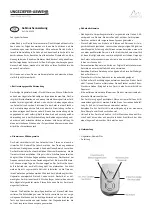
PRODUCT DESCRIPTION
Outer cabinet (optional)
12 (66)
SKF Multilog On-line System IMx-16Plus
User Manual
Revision Letter A
disallowed as in the IMx-16Plus the 32 Modbus external channels are allocated to
the single master.
The number of slaves supported is reduced by the number of other Modbus
connections, enabled, see earlier note.
When configured specifically as an RTU master to the optional GPS module slave
(
),
(External Communication type ‘GPS50M’, rather
than ‘Modbus’
), @Observer
creates an appropriate Modbus and Modbus external channel configuration for the
GPS data transfer. For more information, refer to the SKF @ptitude Observer User
Manual, Revision Q or later.
The Modbus RTU 2-wire interface can only support one operational mode (either
Master or Slave).
Modbus TCP/IP can only be used if a LAN (rather than mobile data) is being used for
connection to @O or cloud systems and must use the same media/interface (RJ45 or
Wi-Fi).
For more information regarding Modbus capabilities, refer to "Modbus for SKF
Multilog On-line System IMx and SKF
@ptitude Observer” and also the application
note “Gen
eral Modbus Protocol Considerations for IMx
Devices”.
1.3 Outer cabinet (optional)
Where the IMx-16Plus is not located in an existing cabinet, outer cabinets are
available,
, to house it and any supporting electronics, provide cable gland areas
for sensor, antenna, the GPS and other cables.
The glands used with these enclosures should be chosen to maintain the cabinet IP
rating and be appropriate for the application and environment, cable type and site
practices.
The recommended cable glands sizes for an IMx-16Plus cabinet are M12 x 1,5mm,
M20 x 1,5mm and M25 x 1,5mm. The (pre-drilled) SKF cabinet,
, has two
entries for M25 x 1,5 glands, one entry for a M20 x 1,5mm gland and 14 entries for
M12 x 1,5mm glands. As supplied, all 17 cabinet entries are fitted with blind plugs.
It is not easy to make specific recommendations related to cable glands as it
depends heavily on the application and the site practices, regulations, sensor type
and so on.
In general, from a noise performance perspective it has been seen that noise levels
are often better if an EMC type cable gland (normally metal) is used, but then care
must be taken to:













































